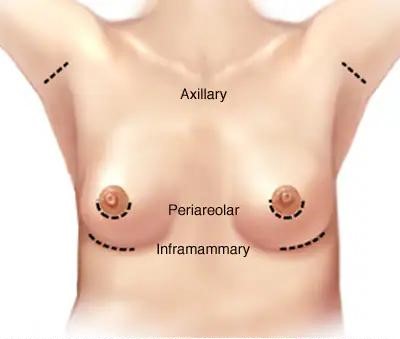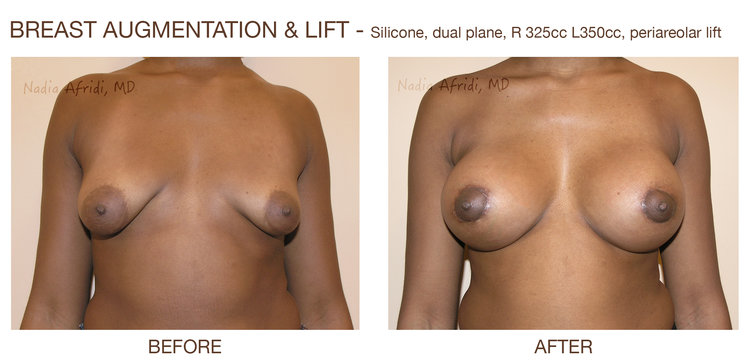Breast augmentation is one of the most frequently performed cosmetic surgery procedures in the U.S. and one of our most popular services in Dr. Afridi’s Manhattan office. Breast augmentation can give women with small or unevenly sized breasts a fuller, firmer, better-proportioned look through the placement of saline or silicone implants behind the breast. Alternatively, patients can also consider subtle and “targeted breast augmentation” with the use of their own fat removed from areas of stubborn accumulation. Dr. Afridi’s patients elect to undergo breast augmentation for many different medical and aesthetic reasons, including balancing breast size, compensating for reduced breast mass after pregnancy or surgery, and correcting a congenital breast defect.
Under Dr. Afridi’s expert care, patients enjoy great-looking, natural-feeling breasts that are one or more cup sizes larger after the operation. When you meet with Dr. Afridi for a breast augmentation consultation in her New York City or Manhasset office, she will discuss your goals and expectations in order to determine whether implants or fat grafting is the better augmentation option for you. If implants are the best choice, then she will discuss different types of breast implants in great detail, providing you with all the information you need to make an informed decision. Dr. Afridi offers the opportunity to “try on the look” during the initial consultation to help select the implant size that’s right for them.

Dr. Afridi emphasizes the importance of considering several key factors when planning breast augmentation surgery:
Carefully evaluating these factors is essential for achieving the best possible outcome for each individual patient.

Implant placement beneath the muscle of the chest offers a few advantages over placement beneath the breast tissue only. These include reduced risk of capsular contracture (post-operative tightening around the implant) and less interference with mammogram examinations. Possible disadvantages include elevated pain in the first few days following surgery and long term displacement of the implant with pressure from the overlying muscle. It is also difficult to achieve the same degree of midline cleavage with the implants under the muscle as compared to under the breast. In the case of patients with deflated breasts after pregnancy, implants under the muscle will not achieve the goal of filling the emptied-out breast as well as under the gland. Dr. Afridi will discuss which option may be best for you.
Choosing the appropriate implant size is crucial to achieving your desired look. Dr. Afridi will listen to your concerns and recommend the appropriate implant size to help you reach the desired cup size. You can also try different implant sizes in a bra to determine the look and feel that suits you best. Dr. Afridi will consider your chest size, body type, and goals when selecting the right implant size
Breast implants are silicone shells filled with either saline (salt water) or silicone gel. Both are different types of breast implants but are very safe, and each offers its advantages. Dr. Afridi offers her patients the option of silicone gel-filled or saline breast implants. Each has its benefits. While silicone gel implants are much softer and feel more natural, saline implants have the benefit of requiring smaller incisions and can be adjusted during the surgery.
Dr. Afridi has extensive experience with both saline breast implants and silicone implants for breast augmentation. Dr. Afridi will help you decide whether silicone breast implants with saline or silicone gel are right for you. (At this time, silicone implants are only FDA approved for 22 and older)
Nipple reconstruction addresses inverted or stretched nipples that can make the breasts look aged or unattractive. This procedure reshapes one or both nipples to achieve a pleasing and youthful appearance. Several techniques can be used, including tissue and cartilage flaps, and skin grafts. Nipple reconstruction can be performed independently or as a second- or third-stage procedure in breast reconstruction in individuals who have already undergone surgery.
Achieving a natural and symmetrical result requires precision and expertise. During your consultation, Dr. Afridi will discuss your specific concerns and recommend the most appropriate technique based on your anatomical needs and aesthetic goals. Whether utilizing tissue flaps, which involve reshaping and repositioning a small portion of breast tissue, or opting for skin grafts to achieve realistic pigmentation, each method is meticulously planned to ensure optimal results.
Recovery from nipple reconstruction is typically swift, allowing patients to return to their normal activities shortly after the procedure.
Autologous Fat Grafting (AFT) harvests fat from stubborn areas through liposuction and transfers it to the breasts. Common donor sites include the abdomen, thighs, and flanks. The purified fat is injected into the breasts to enhance volume and shape.
Body Contouring: It slims donor areas, offering a more toned appearance. Minimal Scarring: Small incisions result in minimal scarring compared to implants. Upper Breast Fullness: Achieving a more youthful look. Medial Cleavage: Improving cleavage appearance
Fat Absorption: Some fat is absorbed by the body, requiring multiple sessions. Realistic Expectations: AFT is suitable for modest enhancements and contouring but not for dramatic changes. Patients seeking significant size increases may need multiple sessions, spaced several months apart, to allow fat integration and stabilization. Dr. Nadia Afridi’s Autologous Fat Grafting offers natural breast augmentation with added body contouring benefits. Consult with Dr. Afridi to see if AFT aligns with your aesthetic goals and create a personalized treatment plan.
Tuberous breasts, also known as tubular breasts, are a congenital condition characterized by breasts that have a narrow, constricted base and often appear elongated or droopy. This condition can cause asymmetry, enlarged or puffy areolas, and underdeveloped lower breast quadrants, leading to a less aesthetically pleasing appearance and potential psychological distress.
Tuberous breasts, also known as tubular breasts, are a congenital condition characterized by breasts that have a narrow, constricted base and often appear elongated or droopy. This condition can cause asymmetry, enlarged or puffy areolas, and underdeveloped lower breast quadrants, leading to a less aesthetically pleasing appearance and potential psychological distress.
Dr. Afridi employs a specialized approach to correct tuberous breasts, focusing on creating a natural, balanced, and aesthetically pleasing breast shape. The procedure typically involves:

Breast augmentation recovery time varies from person to person and can take four to eight weeks on average. Factors that can affect recovery time include: